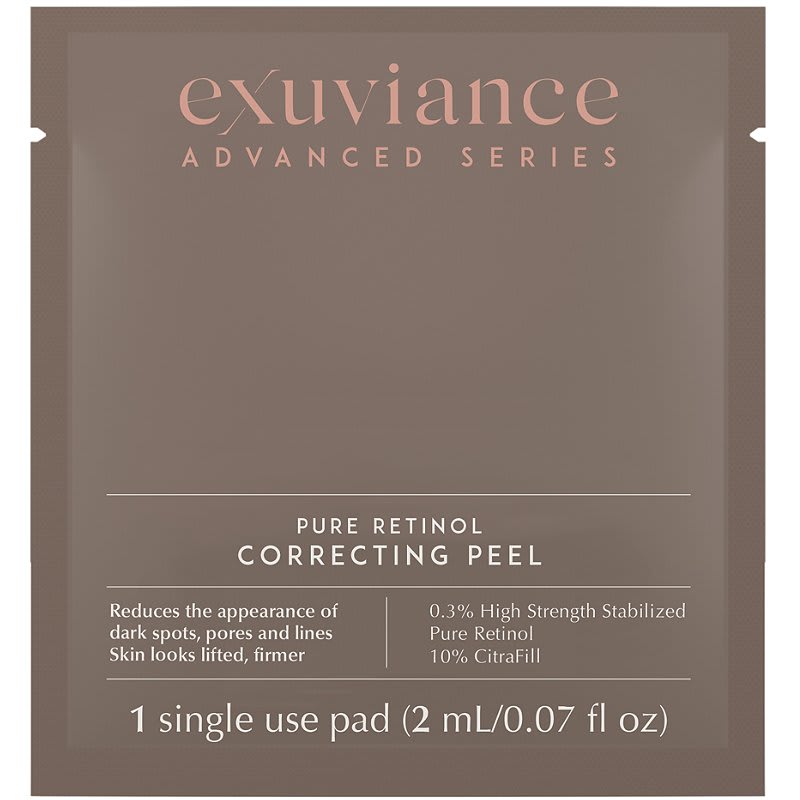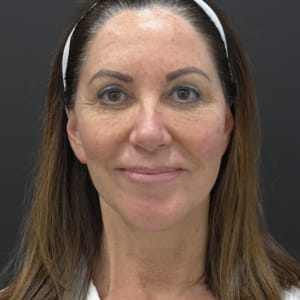
At-Home Treatment Options
![]()
Tria SmoothBeauty Laser ($495)
$495, triabeauty.com
![]()
Exuviance Pure Retinol Correcting Peel ($72)
$72, ulta.com
![]()
GloPRO Microneedling Rejuvenation Tool ($199)
$199, ulta.com
![]()
Drunk Elephant T.L.C. Sukari Babyfacial Mask ($80)
$80, sephora.com
![]()
PCA Skin Micro Peel At-Home Kit ($129)
$129, pcaskin.com
All products featured are independently selected by our editors, however, AEDIT may receive a commission on items purchased through our links.
The Skinny
As the years go by, the effects of life start to show, particularly on the face. Aging, sun exposure, and acne can all leave their marks on the skin, despite your best skin care efforts to erase or prevent them. Blotches, wrinkles, lines, and scars can add entire years onto your appearance as well as affect your self-confidence, perhaps even robbing you of your deserved and full enjoyment in life.
Like many cosmetic skin treatments, laser resurfacing can also restore your confidence and give you the boost you need to enjoy every day to the fullest again. In this article, find out everything you should know about laser skin resurfacing and how it can mean real improvements in your life.
AEDIT
Before & After Images by Provider
This Album Contains Explicit Content. Sign up or Login to Browse Real Before & Afters
Before & After Images by Provider
Laser Skin Resurfacing Solutions
The Specifics
Overview
In this modern age, there is a cosmetic procedure for almost every outer part of the body—especially the face. Because our faces are one of the first things people notice about us, it’s quite reassuring to have the option available to improve your skin tone and smooth out your complexion through cosmetic procedures and surgeries.
Skincare is a fast-growing field, and great strides have been made to both improve existing procedures that have been around for centuries and to create new, innovative ones with modern tools and techniques. Laser resurfacing is a wonderful example of a new cosmetic procedure born out of modern medical research and discovery. While laser technology has been used in general medical surgeries for more than thirty years, using lasers for cosmetic plastic surgery--and in particular for laser resurfacing treatments--is a relatively new application. Since its introduction to the beauty scene around fifteen years ago, significant research and testing have been done to improve the effects and safety of laser resurfacing, and the procedure is now considered a powerful tool for skin enhancement.
As a result, skin resurfacing is quickly becoming one of the most effective facial resurfacing techniques today. If you’re interested in having this procedure done, this guide will help you learn more about the process so that you can determine whether laser skin resurfacing is the right choice for you.
What is Laser Skin Resurfacing?
Broadly speaking, laser skin resurfacing is designed to reduce facial wrinkles, scars, and blemishes. This cosmetic procedure uses a laser to improve the appearance of skin or to treat minor facial flaws by removing layers of skin. Laser skin resurfacing gets rid of old skin layer by layer with incredible precision, using a laser tool that’s designed to remove the surface of the skin. The new skin cells that form during the healing process give the face a tighter and younger-looking surface.
The procedure can be done alone or with other cosmetic surgeries to achieve your desired outcome.
Do I Need Laser Skin Resurfacing?
Laser Skin Resurfacing is an appropriate treatment for many different skin concerns. It can be suitable for people who are looking to reduce or remove visible signs of aging and skin damage, such as:
The best candidates for laser skin resurfacing treatment will be healthy, with good skin elasticity and a non-oily complexion. Additionally, ideal candidates for laser skin resurfacing will have light to medium skin color and light or moderate wrinkles or blemishes. Those with darker skin tones may have an elevated risk of hyperpigmentation or hypopigmentation and should consult with their doctor about options before deciding on the treatment.
Some medications like Accutane® and Retin-A should not be taken for weeks before having this treatment. As with any cosmetic procedure, patients should always divulge any medications they’re taking or skin enhancement procedures that they’ve had done in the past with their doctor to avoid potential risks or complications from laser skin resurfacing.
It’s important to note that ideal candidates for this procedure will also have realistic expectations about the effects that laser skin resurfacing will have on their skin. While laser skin treatments can be very effective in improving the appearance of the skin, those expecting flawless, perfect skin after treatment are likely to feel disappointed—even if the treatment is generally considered a success.
If you’re interested in laser skin resurfacing, your doctor will evaluate your case to determine whether you’re a good candidate, as everyone’s situation is different. If you and your doctor agree that having the procedure is a good choice for you, laser skin resurfacing is likely to have an excellent effect on your skin that can give you back the confidence you’ve been looking for.
What Benefits Can I Expect From Having Laser Skin Resurfacing?
The goal of laser resurfacing is to improve the appearance of skin by removing the top layers, which helps to remove any minor facial flaws and blemishes like acne, wrinkles, and age spots and other problem areas. By removing the outer layers of the skin, the newer and younger-looking skin underneath is revealed, which can rejuvenate the appearance of skin tone for a tighter and more youthful look.
The effects of laser skin resurfacing vary according to the specific skin type, medical background, and lifestyle of the patient, and individuals will react in unique ways to the different treatments available. In general, most patients can expect to see immediate results following laser skin resurfacing procedure, and the skin’s appearance will continue to improve for up to a year afterward.
While laser skin resurfacing will not stop the natural aging process from taking place, patients can still expect to enjoy the results of their treatment for years after having the procedure.
Who Should Not Have This Procedure?
Laser skin resurfacing is not recommended for patients who have active acne or very dark skin. Patients with darker skin tones have a greater risk of healing with darker pigmentation (hyperpigmentation). This can be minimized by using a bleaching agent after laser skin resurfacing.
Skin resurfacing is also not appropriate for patients with deep wrinkles and excessive or sagging skin.
Will I Be Put Under Anesthesia During My Laser Skin Resurfacing Procedure?
For non-ablative procedures, medication is often given to help the patient relax during the procedure and to minimize any pain. Topical anesthetics are commonly used to numb small treatment areas.
For larger treatments where ablative lasers are used to remove skin layers, local anesthesia or intravenous sedation will be administered to block pain during the procedure.
How Will I Prepare for My Laser Skin Resurfacing?
Before carrying out the procedure, a dermatologist will review your medical history, conduct a physical exam and discuss your expectations.
For the best results, your plastic surgeon may first start you on a series of skin treatments to prepare your skin for the laser procedure. These treatments often begin six weeks or more before your scheduled appointment for laser skin resurfacing. These skin treatments will be customized for your particular skin type to minimize complications and obtain the best results from your laser resurfacing procedure. Your doctor may also ask you not to take any medications or supplements such as aspirin, ibuprofen, or vitamin E for ten days before surgery, as these can affect clotting.
Tell your doctor if you are prone to getting cold sores or fever blisters around your mouth, as laser skin resurfacing can sometimes trigger breakouts.
Patients that smoke should refrain from smoking for at least two weeks before any type of resurfacing procedure. Smoking can prolong healing and cause other issues or complications during treatment. It is also important to stay out of the sun as much as possible both before and after the procedure and to wear broad hats and apply sunscreen if going outdoors is unavoidable.
What Should I Expect After Surgery?
Skin that is treated with laser resurfacing may react in different ways. But most of the time, the highest discomfort you’ll feel will be similar to a mild sunburn. You should expect to have some redness and swelling, though. It’s also common to experience itching or stinging for a few days after the procedure.
Depending on the treatment chosen, some people may develop what looks like a severe sunburn. The skin can become raw or blister. A yellow liquid, or pus, might ooze from treated areas and form a crust over the skin. If this happens, patients are advised not to scratch or pick at these crusted areas to prevent the possibility of scarring.
Following the laser procedure, the doctor will bandage the treated areas. After 24 hours, you will need to clean the treated areas up to five times a day and then apply an ointment such as petroleum jelly to prevent scabs from forming.
Usually, about five days to a week after laser skin resurfacing, your skin will become dry and start peeling. Swelling after laser skin resurfacing is normal, and can sometimes affect the area around the eyes. If this causes a problem for you, your doctor may prescribe steroids to reduce the swelling.
How Can I Help in the Recovery Process?
After your procedure is done, you’ll likely be excited to heal and see the results of your recently resurfaced skin. For the most part, the length of time it takes to recover will come down to following the directions given by your doctor and abstaining from anything that could interfere with your healing.
After your procedure, you can help your skin to heal by following these tips for faster recovery:
Are There Any Potential Side Effects or Complications From Laser Skin Resurfacing?
As with any cosmetic procedure, there are potential risks involved. Your doctor will advise you about the risk and how these can be minimized as much as possible. If something does happen during surgery, you’ll have a qualified professional there with you to make sure any side effects or complications are taken care of quickly and effectively.
In any case, it’s important to be aware of some of the risks of laser skin resurfacing treatments. Here are some of the more common complications that can occur, and what your doctor may do to prevent or deal with them during or after your procedure.
Acne Flares: Your doctor will recommend a treatment regimen to manage this.
Bacterial Infection: To avoid the risk of bacterial infection, you may be advised to begin taking anti-bacterial medication after the procedure to minimize the risk of infection.
Cold Sore Reactivation: Cold sore breakouts can be triggered by laser resurfacing treatments for those prone to cold sores around the mouth. You can prevent the reactivation of cold sores with antiviral medication before your procedure, which will be prescribed to you by your doctor.
Hyperpigmentation: It's possible the treated area can become darker in tone. Your physician may recommend a bleaching solution. In some cases, skin lightening (hypopigmentation) occurs instead.
Milia: During the healing process, you may notice small, white bumps called milia appearing in the treated areas of the skin. They can be removed by gently cleansing the area with a washcloth.
Prolonged redness: For some people, the redness can take longer to disappear.
Scarring: There is a slight risk of scarring during and after laser treatment, usually caused by inefficient post-operative care by the patient or faulty techniques during the procedure. It is very important that the plastic surgeon you choose to perform your treatment is an experienced and certified member of the American Board of Plastic Surgeons or a reputable dermatologist with an equally professional background.
Swelling: This is a common side effect of laser resurfacing. If the swelling is around your eyes, your doctor may prescribe oral steroids to reduce it.
How Much Does Laser Skin Resurfacing Cost?
As with any cosmetic procedure, the cost will depend on a variety of factors, such as the area being treated, the type of procedure being used and the experience of the plastic surgeon. Costs can also vary depending on where the procedure is being done. The average expense for laser skin resurfacing was around $2,330 in 2016, according to the American Society of Plastic Surgeons.
Laser skin resurfacing typically a cosmetic procedure. As a result, most medical insurance companies won’t cover it. There may be an exception if you require the procedure to modify scars or remove precancerous growths on your skin, so check with your doctor for more advice.
Are Results Permanent or Temporary?
Results are permanent, though the effects may be noticeable only temporarily. In other words, the results of laser resurfacing can last for many years, though these results will be affected by the normal aging process. This means that wrinkles and fine lines will reoccur eventually as aging happens.
Healthy eating habits, exercise, limiting alcohol and quitting smoking will all help to reduce the signs of aging of your skin, though it’s important to note that stopping the aging process altogether is impossible.
Laser skin resurfacing can be repeated every few years to maintain and even prolong the results. Ask your doctor about the possibility of repeating the treatment in the future, and what kind of timeline might work for you to achieve the best results over a long period.
What Types of Laser Skin Resurfacing Procedures Are There?
Most lasers used in laser resurfacing treatments will be categorized as either non-ablative or ablative, and fractional or non-fractional.
Ablative lasers are known to be more aggressive treatments than non-ablative, as they obliterate the top layer of the skin to encourage the growth of new skin cells and collagen. Non-ablative lasers, on the other hand, work to gently warm the skin without actually destroying it, for a less dramatic, but effective resurfacing result.
While ablative and non-ablative lasers define the way the skin is treated, fractional and non-fractional lasers, define the area where the laser treatment is applied. Fractional lasers are another type of skin enhancing laser treatment, sometimes used to break up the laser energy into thousands of tiny beams. This creates a precision-effect that allows the provider to focus on only a fraction of the skin in the targeted area, reducing the recovery downtime of the patient. Non-fractional lasers, in comparison, are less precise and focus on the entire surface of treated skin, rather than a small pixel-point of skin at a time. Both non-fractional and fractional lasers can be ablative or non-ablative and are used to treat several age-related blemishes.
Ablative lasers are considered as the most effective laser treatments for skin resurfacing, and ideal for those with severe skin issues like heavy wrinkling, acne scarring, and discoloration. The side effects and potential risks of using ablative lasers can also be more severe, and patients will generally expect to need a significantly longer time to recover from ablative laser treatments.
As mentioned, lasers can be any combination of the two categories, which will affect the overall invasiveness of the procedure. Here is a list of laser types in order of least-invasive, to the most-invasive, and some of the brands of lasers that your medical professional may use for each type of treatment.
Fractional, Non-Ablative: Fraxel™ re::fine, Picosure® FOXUS, Affirm, Starlux, Icon, Fraxel™, Re::store DUAL, Clear & Brilliant®, Pulsed Dye Laser
Non-Fractional, Non-Ablative: Thermascan, CoolTouch®, CT3Plus, Harmony XL, SmoothBeam®, Laser Genesis
Fractional, Ablative: Pixel CO2, SmartSkin®, DEKADOT™, Ellumine, NaturaLase CO2, MIXEL, Fraxis, Ultrapulse® ENcore, AcuPulse™ MultiMode, Fraxel™ re:pair, CO2RE™, Pixel® 2940, Icon™ 2940 Fractional, Sciton ProFractional™ (XC), Cutera Pearl™ Fractional
Non-Fractional, Ablative: UltraPulse®, AcuPulse™, Matrix LS-40, NaturaLase, Contour TRL™, SmoothPeel™
There are several options for laser skin resurfacing, depending on the patient and the skin concern being addressed. The two most common types of resurfacing laser treatments are:
Carbon Dioxide (CO2): This type of laser is used to treat wrinkles, scars, warts and other conditions. For years, doctors have used CO2 lasers to treat various skin issues. Nowadays, a newer generation of CO2 lasers has the power to deliver very short pulsed light energy (called ultra-pulsed) or continuous light beams. This type of precision laser removes thin layers of skin with minimal damage to the surrounding tissue.
Erbium: Erbium lasers are a type of ablative lasers that are used to remove deep lines and moderate wrinkles on the face, hands, neck, and chest. It usually causes fewer side effects than CO2 lasers.
Other types of lasers can be used to carry out resurfacing procedures as well, such as pulsed-dye lasers. These are typically non-ablative lasers that heat the skin and absorb pigments to reduce redness, hyperpigmentation, broken capillaries, and rosacea.
IPL (intense pulsed light) treatments technically are not lasers but are another way to treat similar concerns as lasers would tackle, such as sun damage, acne scars, rosacea, and hyperpigmentation.
Laser skin resurfacing is usually done on an outpatient basis, and the procedure typically takes between 30 minutes to two hours.
What is Recovery Like?
Depending on the problem that was treated and the resurfacing method that was used, recovery time will usually take anywhere from ten to 21 days, though individual recovery times will vary. Specifically, the recovery time for CO2 laser resurfacing will generally take up to two weeks, while erbium laser resurfacing usually takes one full week to recover.
Once the skin is healed, patients can begin to wear oil-free makeup to minimize redness, which usually fades within two to three months.
You’ll also probably notice that your skin is somewhat lighter for a while after your surgery. Use a broad-spectrum sunscreen, which screens ultraviolet B and ultraviolet A rays to protect your skin during that time. You should also look for a sunscreen that is specially formulated for use on the face with a 7% (or higher) zinc oxide content, and a sun protection factor (SPF) of 30 or higher. Limiting your time in the sun will be important, especially between the hours of 10 am and 2 pm. Wearing protective clothing, such as long-sleeved shirts, pants, and a wide-brimmed hat is necessary.
It’s also important to keep your new skin well-moisturized. If you use Retin A or glycolic acid products, you should be able to start using them again after about six weeks, unless your doctor says otherwise.
After peeling, the new, rejuvenated skin will be pink, but it will gradually lighten over two to three months. It may take up to one year for the pinkness to go away. Redness tends to last longer in patients with blonde or red hair.
The Takeaway
Conclusion: The Pros and Cons of Laser Skin Resurfacing
Laser skin resurfacing can dramatically improve your skin tone and appearance. It removes layers of skin to reveal new skin that looks both younger and fresher, and the results can last for many years. The procedure can reduce the damage caused by sun exposure, acne scars, fine lines, and blemishes. The recovery process is relatively quick, and complications can be managed.
The drawbacks of laser skin resurfacing are that it’s not suitable for every skin type and it can’t always remove the deepest of wrinkles. This cosmetic procedure does come with potential side effects like the risk of infection, swelling, redness and stinging.



















